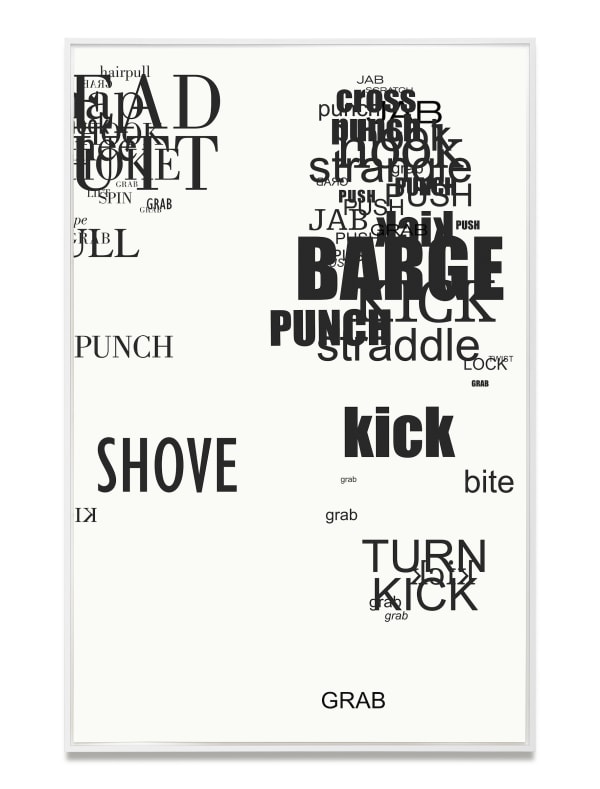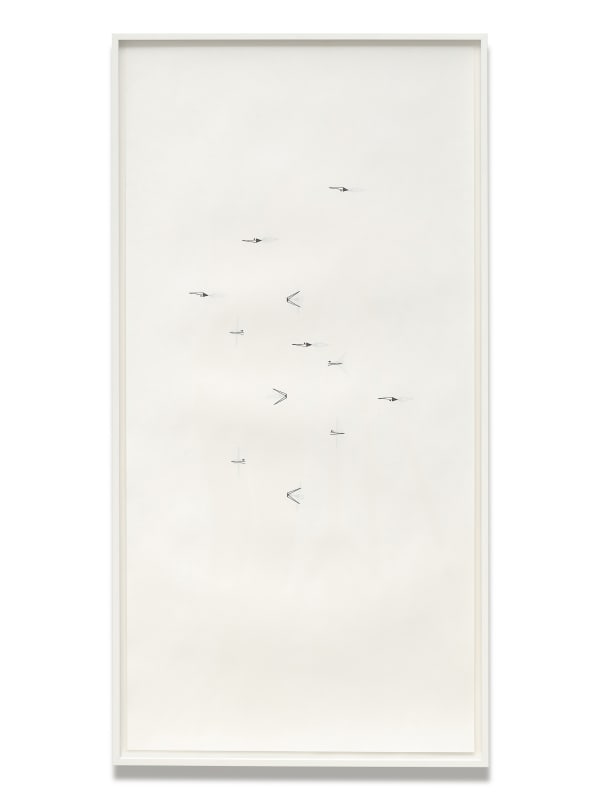JANICE KERBEL: Sinkfight
If Janice Kerbel’s medium is language and other abstract systems, her implied one is the human body.
Each of the large-scale silkscreen prints in her series Brawl (2018) consists of verbs and nouns printed in different fonts and deployed, sometimes almost strewn, across a portrait-orientated paper. Not only action words, but brusquely violent ones: jab, grab, head butt, punch, push, barge and straddle, to name but a few. The scale of the paper echoes the human body, or the space of a body, and the prints, with the words printed in the pictorial space as if in the space of a fight, could be either a set of commands from an unseen choreographer or the narration of an event, live or fictional. The viewer experiences a gap between an abstract pattern of signs and the slapstick physicality of what they signify, or attempt to signify. The result is a lingering absence.
Kerbel’s Sink (2018) prints produce a similar effect. Treating the shape and surface of the paper as if it were a rectangular pool, there are small, abstracted human forms that represent individual swimmers that through repetition become a pattern. The marks inhabit the space in a range of different positions, shapes and densities, small parts of an overall whole that takes on its own distinct character. The figures might have their precise, arrow-like arms pushed forward, or their legs spread like the arms of a compass, or they might fold up into a tiny, geometric mark of black ink. The small, incorporeal forms refer to fleshy bodies immersed in water, an implied sensual abundance.
Both Brawl and Sink have an austere presence despite describing the potentially chaotic actions of imperfect bodies. Yet fights and swims have their own abstract systems and conventions: the words ‘upper cut’ on one of the Brawl prints describes a motion that is formal and practiced, if delivered in a particular way at a particular time. Synchronised swimming is, of course, highly formalised: the sport’s appeal lies in the symmetrical, timed routines which seems to defy nature. Both sets of prints trigger in the viewer’s imagination this discrepancy between abstract systems and the particular bodies – and events – they might activate.
But we return to looking at the works on paper as objects, as bodies with their own properties of position, weight and tactility: in Brawl, we see the depth and solidity of the ink, the ridged edges of the letterforms, detect the increased thickness where letters overlap. In Sink, Kerbel is alert to the qualities of the paper, printing on both sides, exploiting the subtle translucency to suggest submersion, with the surface of the paper acting as the surface of the water. Each of the Sink prints are hand-stamped, introducing the inexact gestures of the artist’s body.
Kerbel starts by looking into the gap between abstract signs and the actions they signify, and pushes that space open even further. Sink and Brawl demand a response from the viewer: you smash and shove your own imagination, grapple with the question of how, engaged by any human consciousness, immaterial ideas can conjure vivid bodily form.
Janice Kerbel (b. 1969, Toronto) lives and works in London. Sink was performed live at the Western Baths, Glasgow; it was commissioned by The Common Guild Glasgow in 2018. Recent exhibitions include ‘Beautiful World Where Are You?, Liverpool Biennial’ (2018); ‘Fight’, greengrassi, London (2018); ‘Alphabet’, Hamburger Kunsthalle (2018); ‘Space Force Construction’, V-A-C Foundation, Venice (2017); ‘Doug’, Fundaçao de Serralves, Porto, Portugal (2017); ‘Le Grand Balcon: Montreal Biennial’ (2017); ‘Score’, Catriona Jeffries, Vancouver (2015); ‘Turner Prize 2015’, Tramway Glasgow; Arts Club of Chicago (2012); ‘Kill the Workers!’, Chisenhale Gallery (2011); and ‘See It Now’,Art Now: Tate Britain (2010).
Doug was nominated for the Turner Prize in 2015; it was commissioned by The Common Guild, Glasgow in 2014.


















